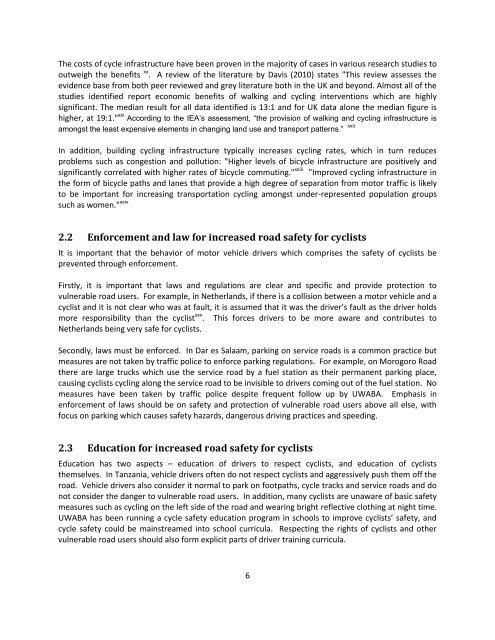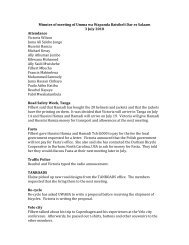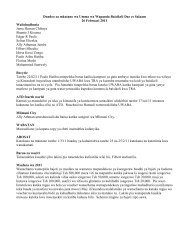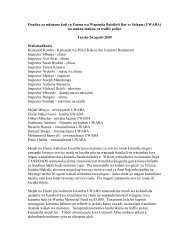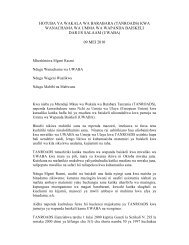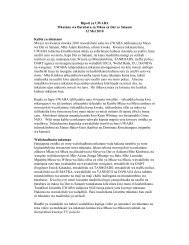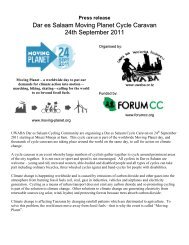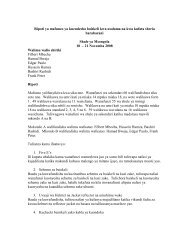Abstract 1 Importance of increasing road safety for ... - Uwaba.or.tz
Abstract 1 Importance of increasing road safety for ... - Uwaba.or.tz
Abstract 1 Importance of increasing road safety for ... - Uwaba.or.tz
You also want an ePaper? Increase the reach of your titles
YUMPU automatically turns print PDFs into web optimized ePapers that Google loves.
The costs <strong>of</strong> cycle infrastructure have been proven in the maj<strong>or</strong>ity <strong>of</strong> cases in various research studies tooutweigh the benefits xx . A review <strong>of</strong> the literature by Davis (2010) states "This review assesses theevidence base from both peer reviewed and grey literature both in the UK and beyond. Almost all <strong>of</strong> thestudies identified rep<strong>or</strong>t economic benefits <strong>of</strong> walking and cycling interventions which are highlysignificant. The median result <strong>f<strong>or</strong></strong> all data identified is 13:1 and <strong>f<strong>or</strong></strong> UK data alone the median figure ishigher, at 19:1." xxi Acc<strong>or</strong>ding to the IEA’s assessment, “the provision <strong>of</strong> walking and cycling infrastructure isamongst the least expensive elements in changing land use and transp<strong>or</strong>t patterns.” xxiiIn addition, building cycling infrastructure typically increases cycling rates, which in turn reducesproblems such as congestion and pollution: "Higher levels <strong>of</strong> bicycle infrastructure are positively andsignificantly c<strong>or</strong>related with higher rates <strong>of</strong> bicycle commuting." xxiii "Improved cycling infrastructure inthe <strong>f<strong>or</strong></strong>m <strong>of</strong> bicycle paths and lanes that provide a high degree <strong>of</strong> separation from mot<strong>or</strong> traffic is likelyto be imp<strong>or</strong>tant <strong>f<strong>or</strong></strong> <strong>increasing</strong> transp<strong>or</strong>tation cycling amongst under-represented population groupssuch as women." xxiv2.2 En<strong>f<strong>or</strong></strong>cement and law <strong>f<strong>or</strong></strong> increased <strong>road</strong> <strong>safety</strong> <strong>f<strong>or</strong></strong> cyclistsIt is imp<strong>or</strong>tant that the behavi<strong>or</strong> <strong>of</strong> mot<strong>or</strong> vehicle drivers which comprises the <strong>safety</strong> <strong>of</strong> cyclists beprevented through en<strong>f<strong>or</strong></strong>cement.Firstly, it is imp<strong>or</strong>tant that laws and regulations are clear and specific and provide protection tovulnerable <strong>road</strong> users. F<strong>or</strong> example, in Netherlands, if there is a collision between a mot<strong>or</strong> vehicle and acyclist and it is not clear who was at fault, it is assumed that it was the driver’s fault as the driver holdsm<strong>or</strong>e responsibility than the cyclist xxv . This <strong>f<strong>or</strong></strong>ces drivers to be m<strong>or</strong>e aware and contributes toNetherlands being very safe <strong>f<strong>or</strong></strong> cyclists.Secondly, laws must be en<strong>f<strong>or</strong></strong>ced. In Dar es Salaam, parking on service <strong>road</strong>s is a common practice butmeasures are not taken by traffic police to en<strong>f<strong>or</strong></strong>ce parking regulations. F<strong>or</strong> example, on M<strong>or</strong>og<strong>or</strong>o Roadthere are large trucks which use the service <strong>road</strong> by a fuel station as their permanent parking place,causing cyclists cycling along the service <strong>road</strong> to be invisible to drivers coming out <strong>of</strong> the fuel station. Nomeasures have been taken by traffic police despite frequent follow up by UWABA. Emphasis inen<strong>f<strong>or</strong></strong>cement <strong>of</strong> laws should be on <strong>safety</strong> and protection <strong>of</strong> vulnerable <strong>road</strong> users above all else, withfocus on parking which causes <strong>safety</strong> hazards, dangerous driving practices and speeding.2.3 Education <strong>f<strong>or</strong></strong> increased <strong>road</strong> <strong>safety</strong> <strong>f<strong>or</strong></strong> cyclistsEducation has two aspects – education <strong>of</strong> drivers to respect cyclists, and education <strong>of</strong> cycliststhemselves. In Tanzania, vehicle drivers <strong>of</strong>ten do not respect cyclists and aggressively push them <strong>of</strong>f the<strong>road</strong>. Vehicle drivers also consider it n<strong>or</strong>mal to park on footpaths, cycle tracks and service <strong>road</strong>s and donot consider the danger to vulnerable <strong>road</strong> users. In addition, many cyclists are unaware <strong>of</strong> basic <strong>safety</strong>measures such as cycling on the left side <strong>of</strong> the <strong>road</strong> and wearing bright reflective clothing at night time.UWABA has been running a cycle <strong>safety</strong> education program in schools to improve cyclists’ <strong>safety</strong>, andcycle <strong>safety</strong> could be mainstreamed into school curricula. Respecting the rights <strong>of</strong> cyclists and othervulnerable <strong>road</strong> users should also <strong>f<strong>or</strong></strong>m explicit parts <strong>of</strong> driver training curricula.6


